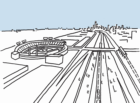Together with China-based architecture firm gad, we have won the international competition to design the Hangzhou Science and Technology Innovation Central Business District (CBD) in Hangzhou, the capital of China’s Zhejiang province. The master plan envisions a dynamic regional hub that integrates advanced transit connections with the characteristic landscape of the Jiangnan region, creating a flexible framework to foster creativity and support the growth of technology industries.
Spanning 3.7 square kilometers, the CBD is a central component of the Hangzhou West Science and Technology Innovation Corridor. The design capitalizes on the West Station hub’s transportation network—including rail and expressway connections—to enhance regional and national accessibility. As a cornerstone of Hangzhou’s urban strategy, the CBD aims to optimize the city’s layout and establish it as a global tech hub.
“In cities, the one constant is change, and nowhere is this more evident than in Hangzhou, where tradition balances with modernity,” says SOM Partner Doug Voigt. “We are now proud to unveil a vision for a new district where regional ecology, wellness, and sustainability are woven into the city’s evolving economy.”








